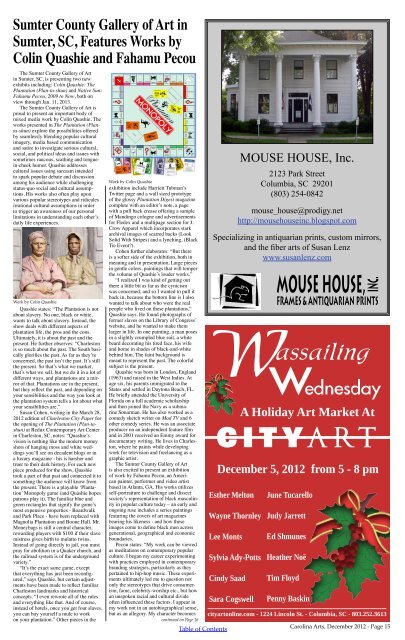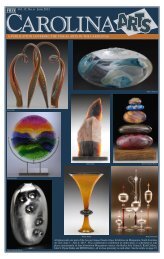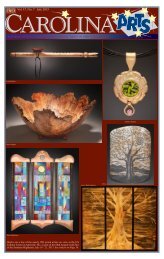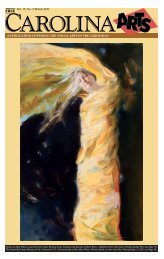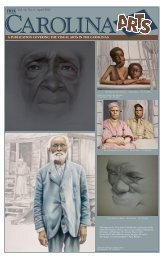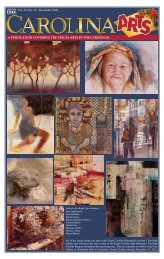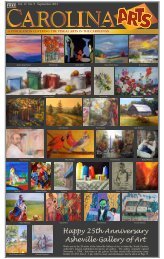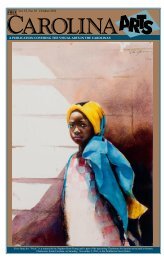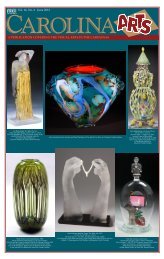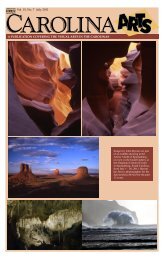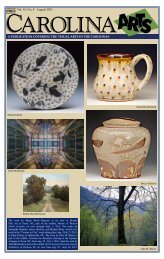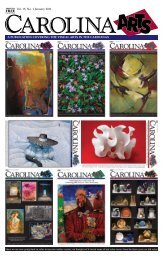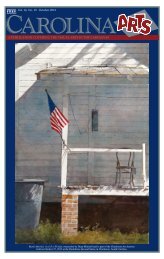NC Institutional Galleries - Carolina Arts
NC Institutional Galleries - Carolina Arts
NC Institutional Galleries - Carolina Arts
Create successful ePaper yourself
Turn your PDF publications into a flip-book with our unique Google optimized e-Paper software.
Sumter County Gallery of Art in<br />
Sumter, SC, Features Works by<br />
Colin Quashie and Fahamu Pecou<br />
The Sumter County Gallery of Art<br />
in Sumter, SC, is presenting two new<br />
exhibits including: Colin Quashie: The<br />
Plantation (Plan-ta-shun) and Native Sun:<br />
Fahamu Pecou, 2009 to Now, both on<br />
view through Jan. 11, 2013.<br />
The Sumter County Gallery of Art is<br />
proud to present an important body of<br />
mixed media work by Colin Quashie. The<br />
works presented in The Plantation (Planta-shun)<br />
explore the possibilities offered<br />
by seamlessly blending popular cultural<br />
imagery, media based communication<br />
and satire to investigate serious cultural,<br />
social, and political ideas and issues with<br />
sometimes raucous, scathing and tonguein-cheek<br />
humor. Quashie addresses<br />
cultural issues using sarcasm intended<br />
to spark popular debate and discussion<br />
among his audience while challenging<br />
status-quo social and cultural assumptions.<br />
His works also often play upon<br />
various popular stereotypes and ridicules<br />
irrational cultural assumptions in order<br />
to trigger an awareness of our personal<br />
limitations in understanding each other’s<br />
daily life experiences.<br />
Work by Colin Quashie<br />
Quashie states: “The Plantation is not<br />
about slavery. No one, black or white,<br />
wants to talk about slavery. Instead, the<br />
show deals with different aspects of<br />
plantation life, the pros and the cons.<br />
Ultimately, it is about the past and the<br />
present. He further observes: “Charleston<br />
is so much about the past. The South basically<br />
glorifies the past. As far as they’re<br />
concerned, the past isn’t the past. It’s still<br />
the present. So that’s what we market,<br />
that’s what we sell, but we do it in a lot of<br />
different ways, and plantations are a mirror<br />
of that. Plantations are in the present,<br />
but they reflect the past, and depending on<br />
your sensibilities and the way you look at<br />
the plantation system tells a lot about what<br />
your sensibilities are.”<br />
Susan Cohen, writing in the March 28,<br />
2012 edition of Charleston City Paper for<br />
the opening of The Plantation (Plan-tashun)<br />
at Redux Contemporary Art Center<br />
in Charleston, SC, notes: “Quashie’s<br />
vision is nothing like the modern money<br />
shots of hanging moss and white weddings<br />
you’ll see on decadent blogs or in<br />
a luxury magazine - his is harsher and<br />
truer to their dark history. For each new<br />
piece produced for the show, Quashie<br />
took a part of that past and connected it to<br />
something the audience will know from<br />
the present. There is a playable ‘Plantation’<br />
Monopoly game (and Quashie hopes<br />
patrons play it). The familiar blue and<br />
green rectangles that signify the game’s<br />
most expensive properties - Boardwalk<br />
and Park Place - have been replaced with<br />
Magnolia Plantation and Boone Hall. Mr.<br />
Moneybags is still a central character,<br />
rewarding players with $100 if their slave<br />
mistress gives birth to mulatto twins.<br />
Instead of going directly to jail, you must<br />
pray for abolition in a Quaker church, and<br />
the railroad system is of the underground<br />
variety.”<br />
“It’s the exact same game, except<br />
that everything has just been reconfigured,”<br />
says Quashie, but certain adjustments<br />
have been made to reflect familiar<br />
Charleston landmarks and historical<br />
concepts. “I even rewrote all of the rules<br />
and everything like that. And of course,<br />
instead of hotels, once you get four slaves,<br />
you can buy yourself a mule to work<br />
on your plantation.” Other pieces in the<br />
Work by Colin Quashie<br />
exhibition include Harriett Tubman’s<br />
Twitter page and a wall sized prototype<br />
of the glossy Plantation Digest magazine<br />
complete with an editor’s note, a page<br />
with a pull back crease offering a sample<br />
of Mandingo cologne and advertisements<br />
for Fledex and a multipage section for J.<br />
Crow Apparel which incorporates stark<br />
archival images of scarred backs (Look<br />
Solid With Stripes) and a lynching, (Black<br />
Tie Event?).<br />
Cohen further elaborates: “But there<br />
is a softer side of the exhibition, both in<br />
meaning and in presentation, Large pieces<br />
in gentle colors, paintings that will temper<br />
the volume of Quashie’s louder works.”<br />
“I realized I was kind of getting out<br />
there a little bit as far as the cynicism<br />
was concerned, and so I wanted to pull it<br />
back in, because the bottom line is I also<br />
wanted to talk about who were the real<br />
people who lived on these plantations,”<br />
Quashie says. He found photographs of<br />
former slaves on the Library of Congress’<br />
website, and he wanted to make them<br />
larger in life. In one painting, a man poses<br />
in a slightly crumpled blue suit, a white<br />
beard decorating his tired face, his wife<br />
and home in shades of black-and-white<br />
behind him. The faint background is<br />
meant to represent the past. The colorful<br />
subject is the present.<br />
Quashie was born in London, England<br />
(1963) and raised in the West Indies. At<br />
age six, his parents immigrated to the<br />
States and settled in Daytona Beach, FL.<br />
He briefly attended the University of<br />
Florida on a full academic scholarship<br />
and then joined the Navy as a submarine<br />
Sonarman. He has also worked as a<br />
comedy sketch writer on Mad TV and 6<br />
other comedy series. He was an associate<br />
producer on an independent feature film<br />
and in 2001 received an Emmy award for<br />
documentary writing. He lives in Charleston,<br />
where he paints while developing<br />
work for television and freelancing as a<br />
graphic artist.<br />
The Sumter County Gallery of Art<br />
is also excited to present an exhibition<br />
of work by Fahamu Pecou, an American<br />
painter, performer and video artist<br />
based in Atlanta, GA. His works utilizes<br />
self-portraiture to challenge and dissect<br />
society’s representation of black masculinity<br />
in popular culture today – an early and<br />
ongoing ruse includes a series paintings<br />
featuring the covers of art magazines<br />
bearing his likeness - and how these<br />
images come to define black men across<br />
generational, geographical and economic<br />
boundaries.<br />
Pecou states: “My work can be viewed<br />
as meditations on contemporary popular<br />
culture. I began my career experimenting<br />
with practices employed in contemporary<br />
branding strategies, particularly as they<br />
pertained to hip-hop music. These experiments<br />
ultimately led me to question not<br />
only the stereotypes that drive consumerism,<br />
fame, celebrity-worship etc., but how<br />
an unspoken racial and cultural divide<br />
often influenced these factors. I appear in<br />
my work not in an autobiographical sense,<br />
but as an allegory. My character becomes<br />
continued on Page 16<br />
Table of Contents<br />
MOUSE HOUSE, Inc.<br />
2123 Park Street<br />
Columbia, SC 29201<br />
(803) 254-0842<br />
mouse_house@prodigy.net<br />
http://mousehouseinc.blogspot.com<br />
Specializing in antiquarian prints, custom mirrors,<br />
and the fiber arts of Susan Lenz<br />
www.susanlenz.com<br />
MOUSE HOUSE,<br />
FRAMES & ANTIQUARIAN PRINTS<br />
I<strong>NC</strong>.<br />
<strong>Carolina</strong> <strong>Arts</strong>, December 2012 - Page 15


